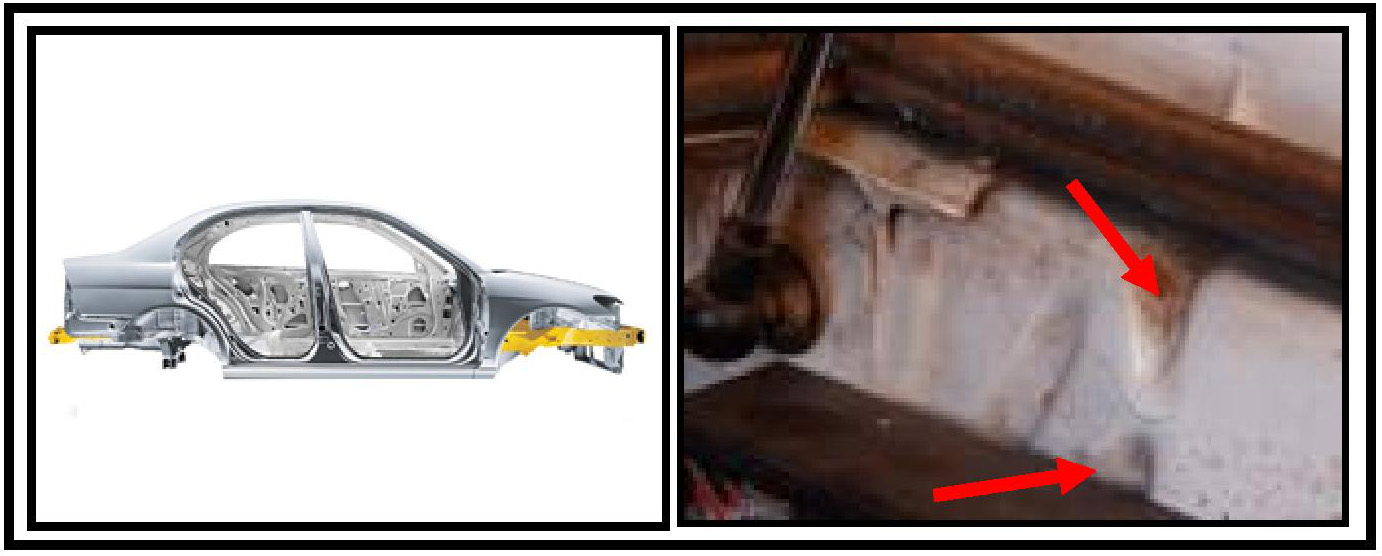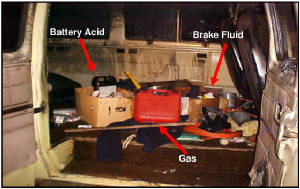|
The rules of vehicle firefighting
And
The tools of good decision making

The Golden Rule of Vehicle Firefighting
If you see open flames upon arrival that vehicle is already
a total loss.
What defines a total loss?
In earlier cars a total loss was determined by the cost of repairs, as
compared to the resale value of the vehicle. Today's cars are all together
different.
In an effort to meet NHTSA's crash safety standards, manufacturers have
redesigned their frames and supports to bend in percise locations to absorb the forces of impact.

|
| Click picture to enlarge |
Enlarge the picture and notice the weak spots in the sheet metal frame and
the harden steel in the crash zones.
These are called crumple zones
These weak spots make it possible for auto makers to predetermine where the car
will bend in a crash. They place these so that the front and rear sheet metal will absorb the impact of the crash before it
reaches the occupant space.
When metal is heated it warps, distorting its original shape. The metal
used in today's cars is very thin and needs very little heat to accomplish this distortion.
This distortion of the crumple zones becomes a treat to the integrity
of the frame and the safety of the occupant in a future crash.
Therefore it is deemed a total loss.

|
| Click picture to enlarge |
$1000 or $175,000 it is still a total loss.
Do not risk your life for a $50.00 pile of scrap iron!

A safe attack begins at the station
With all the new technology of today's vehicles, we can not safely attack
a vehicle fire, if we do not know the systems we are facing and the dangers
they present us.
Training It Is A Must!

Just like any fire a safe attack depends on a good
size-up
A good size-up is a four part process
1. Dispatch size-up
2. Approaching size-up
3. Arrival size-up
4. On scene size-up
Dispatch size-up starts when you roll out the door:
Always repeat the address back to dispatch.
Ask for additional information; is this vehicle on the road, in a driveway,
or in a garage?
Is this vehicle a car fire or a fire resulting from a collision?
Know your area, if this vehicle is on a roadway, is it a high traffic
area?
Why ask for additional information?
If this vehicle is on the highway, we need PD in route now for traffic control.
If it is in a driveway or garage, we need engine companies in route now for a possible
structure fire.
If it is a result of a collision, we need ALS in route now for possible ijuries.
Remember!
We can always disreguard incoming help
A lot of people do not realize that some departments, especially
volunteer, may have a ten to twenty minute response time and miles of area to cover. If we wait until we arrive on scene
to call for help, that help has the same or more response time.
Approaching size-up:
Away down the road we can start to redefine our dispatch size-up.
What does this area look like? Is there woods or high grass on the side of the road,
exposures we didn't know about?
What is the wind direction? I need my apparatus parked up wind from the fire.
Topography (Is the vehicle on a hill?)
Dangers to the crew (Is there oncoming traffic?)
What are the onlookers doing? (Maybe rescue)
Arrival size-up:
While still in the truck we can start to redefine our approaching size-up.
Do I see open flames? How much fire do I have? Do I need an extinguisher or an 1
3/4 hose line?
Is the vehicle occupied?
Is it a late model car or an older one, (example I have a late model Honda Civic)
What category is the fire? (front end, rear end, compartment or fully involved)
Do I need more help?
On scene size-up:
A 360 walk around of the scene should totally redefine the other three.
How much fire is showing?
Are all occupants out of the car? Is there any injured occupants that have already
exited the vehicle.
Is this a late model car or an older one? (Back to our example: I have
a late model Honda Civic Hybrid vehicle)

A Good Size-up is a Practiced Skill
Not a Spur of the Moment Decision

Vehicle Fire Categories
All vehicle fires can be put into four categories:
Front end fire: From the front bumper to the
inter dash board.
Rear end fire: From the rear seat to the rear
bumper.
Compartment fire: From the dash board to
the rear seat.
Fully involved fire: From bumper to bumper,
or a combination of any two of the others
By categorizing the fire in our size-up we can initiate
a safer, faster attack.
Looking back at all of the new technologies we have studied, you will find some
47 different dangers and with manufacturers already producing cars like BMW, with options for twenty two airbags in one vehicle,
plus all of the other dangers we have studied, it is impossible for rescuers to remember everyone of these dangers and
their locations.
But, can we remember:
Front end fires can have:
Front bumper struts
Hood struts
Two front tires that can blow
Possible compressed gas inflators in the A posts
Possible magnesium parts
Rear end fires can have:
Rear bumper struts
Two rear tires that can blow
Possible compressed gas inflators in the C or D posts
Possible plastic gas tank
Pressurized fuel lines
By categorizing the fire, we can train our minds to prioritize the dangers
we face in that particular area of the car. Thus helping us to make a safe, but faster decision as to our plan of attack.
Example: Rear
end fire:
Size-up:
Rear end fire, Late model car, Down hill topography
Thought of attack:
In just a few minutes I could have a stream of burning gas running down the hill;
Evacuate the area, have the crew attack from the side of the vehicle concentrating
on keeping the tank cool and prepare material for damming and stopping the flow.

Size-up is a fast skilled decision
Can categorizing the fire help?

Apparatus Placement
Another important part of a safe attack
If at all possible the apparatus should always be parked up-wind from
the burning vehicle.
Today's vehicles can range from about 20% to 60% hydrocarbon
based plastics, which put off hundreds of different toxic gases. These vehicles also produce thick black smoke, impairing
the visibility on scene.
The apparatus must always be parked up-hill from the burning vehicle.
For years this as been a part of our training but today this is no longer an option,
with so many of today's vehicles being equipped with plastic gas tanks and pressurized plastic fuel lines, it is a must!
Direction of the apparatus:
The pump panel should always face the burning vehicle, this gives the engineer a
clear view of the whole scene.
On the highway this also gives the engineer protection from oncoming traffic.
Positioning the apparatus:
If the vehicle is on the highway or the shoulder of the road, the apparatus should
be placed diagonally, blocking the lane the vehicle is in and at least the next adjacent lane. This places about an 80,000
pound wall between your crew and oncoming traffic.

Water supply and fire streams
For years many have used a one inch line or redline to fight a vehicle
fire.
With the new technologies we are facing today, we need a lot of water,
real fast, from a long distance.
With plastic gas tanks, pressurized fuel lines and dozens of compressed
gas canisters to explode, we need a fast knock down, from a long distance before approaching the vehicle.
We should always use at least an 1 3/4 line and an adjustable nozzle
to attack a vehicle fire.
This give us more pressure to wash out under the vehicle and cool the
gas tank from a safe distance.
This give us more water to cool the fire and a fog stream to protect
our crew in case of a flash of fire, such as one of these tanks failing.

There are some rules in vehicle firefighting
that should never be broken.
1. Never approach a burning vehicle
without fully bunker gear.
The materials used in today's vehicles put off deadly poison gases and
these materials also add much more fuel to the fire making them much hotter than the older vehicle we use to have.
They will kill you!
2. Never risk injury to save a burning car, it was already junk when you arrived on scene.
Remember the golden rule, if you see open flames upon arrival that vehicle is already
a total loss.
Is your life worth less than $50.00 in scrap iron?
3. Never cross in front of the burning end
of a vehicle.
Remember the video where the bumper blow off, hitting the firefighter, or the picture
of the bumper strut still in the air?
Remember the hood strut stuck in the mans leg?
This could be you!
4. Never enter the vehicle with any part
of your body until every piece of that vehicle is completely cooled.
Remember the airbags blowing out through the roofs and the inflators
throwing shrapnel in all directions?
These are handgrenades with the pins already pulled!
5. Never open the hood, trunk lid, or hatch
back without first bending the edge and cooling the struts.
Many of these are mounted on nylon sockets that are probably melted and the hot
cylinder has built up pressure inside. Again remember the man's leg.
These are for real!

Expect the unexpected on every vehicle fire

|
| Click picture to enlarge |
While putting this class together we were dispatched to a fully involved
early model van. This was a very routine type vehicle fire with none of the new technologies involved. Just like old
times, a simple knock down and put the fire out. There were no bumper struts, no hood struts, no airbags and no canisters
to explode.
Enlarge the picture and see what we found as we opened the rear doors, after
the fire was knocked down.
Notice the heat that had already reached the area.

|

